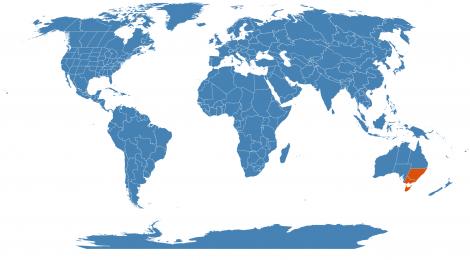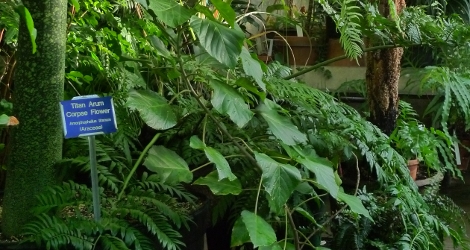Accession Data:
Eucalyptus globulus Labill.
- Common Name: Tasmanian Blue Gum
- Family: Myrtaceae Juss.
- Country of Origin: New South Wales to Tasmania

- Habitat: Damp marshy areas on moist loams and clays in coastal region
- Description: Blue Gum Eucalyptus is an evergreen tree that reaches a height of 15 meters or more. Bark is grayish, peeling off in thin, long strips, whitish gray underneath. Young leaves are cordate, glaucous-blue, and clasping the stem. Mature leaves are leathery, lanceolate, dark green, usually somewhat sickle-shaped, more than 30 centimeters long. Flowers are white, about 1.5 centimeters in diameter. Fruit is obovoid or somewhat rounded, about 8 millimeters in diameter.1
- Uses: Oils are in classified into:
- medicinal, containing eucalytol or cineol
- industrial, containing terpenes, used in mining operations
- aromatic, as in E. citriodora
Considered anesthetic, antibronchitic, antiseptic, anticatarrh, antiparasitic, antirheumatic, antispasmodic, antiviral, cooling, anti-inflammatory, diuretic, febrifuge, rubefacient, analgesic, insect repellent, sedative, expectorant, stimulant.1
- IMPORTANT NOTE: Plant Uses are for informational purposes only. EEB Greenhouses assume no responsibility for adverse effects from the use of any plants referred to on this site. Always seek advice from a professional before using any plant medicinally.
- USDA Zone: 8-10
Accession Data:
- Accession # 200400173
- Source: Jeff Smith - Connecticut College
- Accession Date: 09-20-2004
- Bench: 2317 - Sm Aquatic Tanks
- Currently: active - healthy
- Qty: 1 confirmed on 09-16-2024
Classification:
- Division: Magnoliophyta
- Class: Magnoliopsida
- SubClass: rosids
- Order: Myrtales
- SubOrder:
- Family: Myrtaceae
- SubFamily: Myrtoideae
- Tribe: Eucalypteae
- SubTribe:
References (internal):
- Medicinal Plants
- Beverage Plants
- Dye Plants
- EEB 3271 - Systematic Botany
- Medicinal Plants - Traditional African Medicine
- EEB Greenhouse Holdings native to: New South Wales / Tasmania / Victoria /
References (external):
- Eucalyptus at Philippine Alternative Medicine. Last accessed Tuesday, 18 December, 2018.
- The Plant List (2013). Version 1.1. Last accessed on Tuesday, 18 December, 2018.
- WCSP (2015). World Checklist of Selected Plant Families. Facilitated by the Royal Botanic Gardens, Kew. Last accessed on Tuesday, 18 December, 2018.
data regenerated on Wed, 13 Nov 2024 15:06:09 -0500 [bcm v4.0]
Images:

Additional images for this accession:
Click on thumbnails to enlargeCurrent Accessions in the Myrtaceae
Subfamily Myrtoideae
Tribe Eucalypteae
Subfamily Myrtoideae
Tribe Leptospermeae
Subfamily Myrtoideae
Tribe Melaleuceae
Subfamily Myrtoideae
Tribe Metrosidereae
Subfamily Myrtoideae
Tribe Myrteae
- Acca sellowiana


- Eugenia brasiliensis


- Eugenia uniflora

- Myrtus communis `Microphylla'

- Pimenta dioica

- Plinia cauliflora


- Psidium cattleianum


- Psidium guajava


- Ugni molinae

Subfamily Myrtoideae
Tribe Syzygieae
Subfamily Psiloxyloideae
Tribe Heteropyxideae
W/C = Wild Collected
 = indicates flowering in past 14 days
= indicates flowering in past 14 days
 = images available for this accession
= images available for this accession
 = map available for this accession
= map available for this accession
 = accession added within past 90 days
= accession added within past 90 days